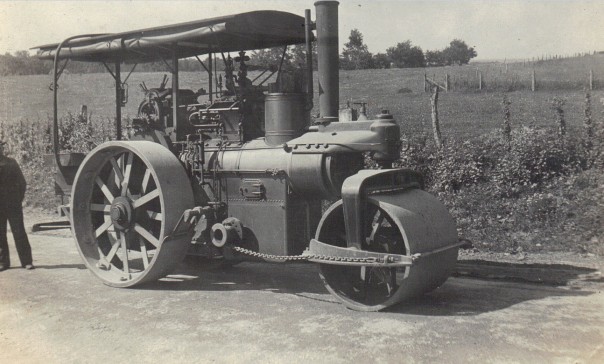Early Montgomery County Road Paving Equipment
These vehicles below, strangely recognizable as forerunners to our modern equivalents, date from 1909. At this time, a lot of the equipment was still horse-drawn, such as the horse-drawn tanker wagon. Steamrollers (more correctly called road rollers) were literally powered by steam, like locomotives, and were similar to motorized farm vehicles of the time period. Road rollers were the last type of steam engine to be used on the roads. Before the hot tar has a chance to cool, sand, small pebbles, or small pieces of crushed rock are spread on top of it and compacted with a road roller, which also helps to bind it all together into a long-wearing, waterproof pavement.
The early 1900s paving truck seen in the photo above is equipped with a high-powered spray mounted on the back of the truck. The truck consists of a storage tank, a burner below it to keep the asphalt hot and liquid, and a pump to pressurize it and send it to the spray bar and through the nozzles in the back. You can see the massive chain that puts power to the rear wheels.
Before the hot tar has a chance to cool, sand, small pebbles, or small pieces of crushed rock are spread on top of it and compacted with a steamroller that’s powered by steam, which also helps to bind it all together into a long-wearing, waterproof pavement.
This take-off of the steam traction engine was designed specifically for road building and flattening ground mimicking today’s modern rollers used for compacting road surfaces. A single, heavy roller replaced the front wheels and axle and a smoother rear wheels replaced larger wheels without strakes. (strake – name for the diagonal strips cast into or riveted onto the wheel rims to provide traction on unmade ground).

STEAM ROAD ROLLER, 1909. Note the horse-drawn flusher adjacent to the steamroller – photograph by Lewis Reed
In 1900, ninety percent of the roads in Maryland were dirt roads; in Montgomery County the figure was ninety-five percent. In 1909 the State Roads Commission paved the 5.47 miles of Old Georgetown Road with a six-inch macadam covering, and the state did further paving in 1921, 1923, 1926, 1927 and 1929. You can see how much things have changed for the people who work on our roads.
Photos cannot convey the raw power of a steam road roller: the way its pistons, valves, gears, and wheels are locked in constant motion. You really have to see this machinery in action.
Here is a video of a vintage steam roller in action as it chugs along past a camera.











Thank you for the insightful and fascinating exploration of early Montgomery County road paving equipment! Your blog not only sheds light on the technological advancements of the past but also highlights the importance of infrastructure development in shaping communities.- Beatriz Barata